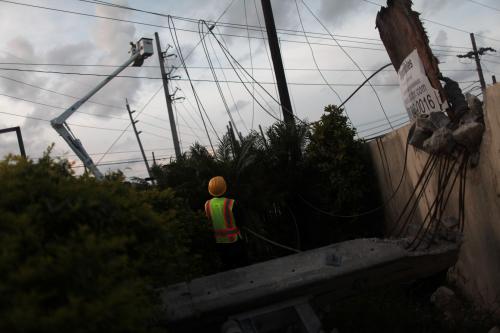The Bureau of Labor Statistics (BLS) employment report released today shows that 148,000 jobs were added in December. In this blog post, I report results from three alternative projections, each of which was calculated using methodology outlined in my past research. Applying a more stable seasonal adjustment to the raw data, and accounting for the effects of weather on employment yields 114,000 jobs, which is 34,000 below the BLS Official number.
Calculating the Alternative Seasonal Adjustment
Monthly job gains and losses can indicate how the economy is doing once they are corrected to account for the pattern the BLS already expects in a process called seasonal adjustment. The approach for this seasonal adjustment that is presently used by the BLS puts very heavy weight on the current and last two years of data in assessing what are the typical patterns for each month.
In my 2013 paper “Unseasonal Seasonals?” I argue that a longer window should be used to estimate seasonal effects. I find that using a different seasonal filter, known as the 3×9 filter, produces better results and more accurate forecasts by emphasizing more years of data. The 3×9 filter spreads weight over the most recent six years in estimating seasonal patterns, which makes them more stable over time than the current BLS seasonal adjustment method.
To produce the Alternative Seasonal Adjustment, I calculate the month-over-month change in total nonfarm payrolls, seasonally adjusted by the 3×9 filter, for the most recent month, which you can see in table below. The corresponding data as published by the BLS are shown for comparison purposes. According to the Alternative Seasonal Adjustment, the economy added 135,000 jobs in December, 13,000 fewer than the official BLS total of 148,000.
Calculating the Seasonal and Weather Adjustment
In addition to seasonal effects, abnormal weather can also affect month-to-month fluctuations in job growth. In my 2015 paper with Michael Boldin “Weather-Adjusting Economic Data,” we implement a statistical methodology for adjusting employment data for the effects of deviations in weather from seasonal norms. This is distinct from seasonal adjustment, which only controls for the normal variation in weather across the year. We use several indicators of weather, including temperature and snowfall.
Temperatures in December were about 1½ °C warmer than average, and there were no major snowstorms that could have significantly affected employment. Therefore, I estimate that the BLS overestimated job gains for December by 11,000. The Seasonal and Weather Adjusted estimate for December is thus 137,000 jobs added.
Combining the Alternative Seasonal and Weather Adjustments
Both my Alternative Seasonal Adjustment and Seasonal and Weather Adjustment show lower employment gains than reported by the BLS. One can indeed do the two adjustments jointly—both adjusting for weather effects and using a longer window. This is shown in the far-right column of the table labeled Combined Alternative Seasonal and Weather Adjustment.
Making both adjustments, the employment change in December was an increase of 114,000 jobs, which is 34,000 lower than the BLS Official number.
December marks 87 consecutive months of positive jobs growth. On average, the economy added 170,000 jobs per month in 2017, compared to 191,000 for 2016, 228,000 for 2015, and 234,000 for 2014. With Winter Storm Grayson hitting the Northeast this week, we can expect some negative impacts on January’s employment report next month.
| Thousands of jobs added | BLS Official | Alternative Seasonal Adjustment[1] | Seasonal and Weather Adjustment[2] | Weather Effect[3] | Combined Alternative Seasonal and Weather Adjustment[4] |
|---|---|---|---|---|---|
| 2017-December | 148 | 135 | 137 | +11 | 114 |
| 2017-November | 252 | 277 | 252 | +0 | 283 |
| 2017-October | 211 | 213 | 197 | +14 | 208 |
| 2017-September | 38 | 21 | 48 | -10 | 16 |
| 2017-August | 208 | 206 | 217 | -9 | 217 |
| 2017-July | 138 | 161 | 122 | +16 | 141 |
| 2017-June | 210 | 220 | 208 | +2 | 225 |
| 2017-May | 145 | 132 | 170 | -25 | 150 |
| 2017-April | 207 | 197 | 169 | +38 | 173 |
| 2017-March | 50 | 28 | 104 | -54 | 85 |
| 2017-February | 232 | 257 | 207 | +25 | 219 |
| 2017-January | 216 | 201 | 194 | +22 | 187 |
| 2016-December | 155 | 147 | 161 | -6 | 150 |
Note: Changes in previous months’ numbers reflect revisions to the underlying data.
[1] Applies a longer window estimate of seasonal effects (see Wright 2013).
[2] Includes seasonal and weather adjustments, where seasonal adjustments are estimated using the BLS window specifications (see Boldin & Wright 2015).
[3] BLS Official number less the Seasonal and Weather Adjustment number.
[4] Includes seasonal and weather adjustments, where seasonal adjustments are estimated using a longer window estimate.
The author did not receive financial support from any firm or person for this article or from any firm or person with a financial or political interest in this article. He is currently not an officer, director, or board member of any organization with an interest in this article.






Commentary
Employment growth for 2017 ends on a high note
January 5, 2018